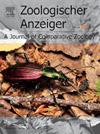Description of a new species of Paraturbanella, new record of Paraturbanella tricaudata and new insights on reproductive traits in Turbanellidae (Gastrotricha:Macrodasyida)
IF 1.5
3区 生物学
Q2 ZOOLOGY
引用次数: 0
Abstract
The intertidal zone of a sandy beach in Bahia State, Brazil, yielded a new species that we describe herein based on three distinct microscopy techniques (light, scanning electronic, and confocal), as well as on nuclear and mitochondrial molecular data (18S rDNA, 28S rDNA, and COI mtDNA). Specimens of Paraturbanella anastaciae species nova (sp. nov.) bear piston pits, a single caudal cone, and lateral and posterior adhesive tubes arranged in clusters; moreover, the layout of its male reproductive system appears unique. A comparative table with data on the reproductive traits of Paraturbanella species known to date was produced to aid future research. Additionally, we report Paraturbanella tricaudata Campos, Todaro and Garraffoni, 2020 from the state of São Paulo, outside its type locality in Rio de Janeiro State. A multigene approach was used to develop a molecular phylogeny of the family Turbanellidae, which found the genera Turbanella and Paraturbanella to be monophyletic and P. anastaciae sp. nov. clearly distinct from other congeners. Although this is the second species of Paraturbanella described from Brazil, evidence indicate that the knowledge of Neotropical turbanellids biodiversity still needs to be completed.
拟蝶属一新种描述、三尾拟蝶属新记录及拟蝶科生殖性状新认识(腹虫目:大腹虫目)
在巴西巴伊亚州沙滩的潮间带发现了一个新物种,我们在此基于三种不同的显微镜技术(光、扫描电子和共聚焦)以及核和线粒体分子数据(18S rDNA、28S rDNA和COI mtDNA)对其进行了描述。小鸟属的标本种nova(十一月种)有活塞坑,一个单一的尾锥,和簇生的侧面和后面的粘着管;此外,它的雄性生殖系统的布局也很独特。制作了一份与迄今为止已知的Paraturbanella物种生殖特征数据的比较表,以帮助未来的研究。此外,我们报告了2020年来自圣保罗州的Paraturbanella tricaudata Campos, Todaro和Garraffoni,位于巴西里约热内卢州的类型地点之外。采用多基因方法对鸡科的分子系统发育进行了研究,发现鸡属和副鸡属是单系的,而鸡属与其他同系物明显不同。虽然这是在巴西发现的第二种Paraturbanella,但有证据表明,对新热带turbanellids生物多样性的认识仍有待完善。
本文章由计算机程序翻译,如有差异,请以英文原文为准。
求助全文
约1分钟内获得全文
求助全文
来源期刊

Zoologischer Anzeiger
生物-动物学
CiteScore
2.80
自引率
7.10%
发文量
75
审稿时长
>12 weeks
期刊介绍:
Zoologischer Anzeiger - A Journal of Comparative Zoology is devoted to comparative zoology with a special emphasis on morphology, systematics, biogeography, and evolutionary biology targeting all metazoans, both modern and extinct. We also consider taxonomic submissions addressing a broader systematic and/or evolutionary context. The overall aim of the journal is to contribute to our understanding of the organismic world from an evolutionary perspective.
The journal Zoologischer Anzeiger invites suggestions for special issues. Interested parties may contact one of the editors.
 求助内容:
求助内容: 应助结果提醒方式:
应助结果提醒方式:


